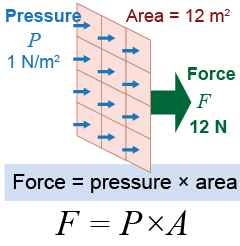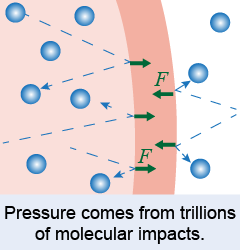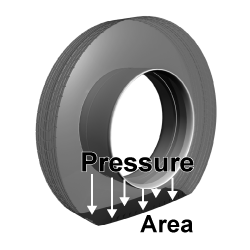|
Both liquids and gases are fluids. A fluid is a form of matter that easily flows and changes shape in response to an applied force. Fluids conform to the shape of their container under the force of gravity. The motion of fluids is important in all areas of science, including the flow of water and air in the environment, aerodynamics, and even blood flow within your body. 
|
Pressure
|
The concept of pressure is important because forces in fluids act differently from forces on rigid solids. Pressure is force per unit area as described by equation (23.7); in the SI system, pressure has units of newtons per square meter (N/m2). In the English system, pressure has units of pounds per square inch (lb/in2), often abbreviated psi. Our atmosphere at sea level has an average pressure of 101,325 N/m2, or 14.7 psi. 
|
| (23.7) | | | P | = | pressure (Pa or N/m2) | | F | = | force (N) | | A | = | area (m2) |
| Pressure
|
|

|
 Pressure creates distributed forces on all surfaces in contact with a fluid. Think about pushing on a bowling ball compared to pushing on an inflated balloon. When you squeeze a balloon the fluid (air) inside exerts a uniform outward pressure everywhere within the balloon. The pressure in the balloon increases until the pressure multiplied by the area of your hand balances the downward applied force. Another way to state equation (23.7) is that force = pressure × area.
Pressure creates distributed forces on all surfaces in contact with a fluid. Think about pushing on a bowling ball compared to pushing on an inflated balloon. When you squeeze a balloon the fluid (air) inside exerts a uniform outward pressure everywhere within the balloon. The pressure in the balloon increases until the pressure multiplied by the area of your hand balances the downward applied force. Another way to state equation (23.7) is that force = pressure × area. 
|
Tire gauges read the gauge pressure, which is pressure in addition to that of the atmosphere. A gauge pressure of 5.3 psi means the absolute pressure is 14.7 + 5.3 = 20.0 psi. 
|
 The cause of pressure is found in the microscopic behavior of atoms, similar to the case for temperature. Think about the air molecules near the inner surface of the balloon. Any molecule that hits the surface bounces back. The act of “bouncing back” is a change in motion that is caused by the balloon surface exerting a force on each air molecule. The reaction force is the molecule exerting a force back against the balloon. Pressure is the result of adding up the reaction forces from trillions of molecules colliding with every square centimeter each second.
The cause of pressure is found in the microscopic behavior of atoms, similar to the case for temperature. Think about the air molecules near the inner surface of the balloon. Any molecule that hits the surface bounces back. The act of “bouncing back” is a change in motion that is caused by the balloon surface exerting a force on each air molecule. The reaction force is the molecule exerting a force back against the balloon. Pressure is the result of adding up the reaction forces from trillions of molecules colliding with every square centimeter each second. 
|
 A car tire is inflated to a pressure of 250,000 Pa (36 psi) above atmospheric pressure. One tire carries 4,900 N, which is ¼ the total weight of the 2,000 kg car. What area of the tire contacts the road? (Hint: Force is pressure multiplied by area.)
A car tire is inflated to a pressure of 250,000 Pa (36 psi) above atmospheric pressure. One tire carries 4,900 N, which is ¼ the total weight of the 2,000 kg car. What area of the tire contacts the road? (Hint: Force is pressure multiplied by area.) - 0.02 m2 (30 in2)
- 36 in2
- 51 m2 (79,000 in2)
- 136 m2 (211,000 in2)
 |
Answer a is correct: The area of tire that contacts the road is 0.02 m2 (30 in2). Since P = F/A, then A = F/P = (4,900 N)/(250,000 Pa) = 0.0196 m which rounds to 0.02 m2. 
|

